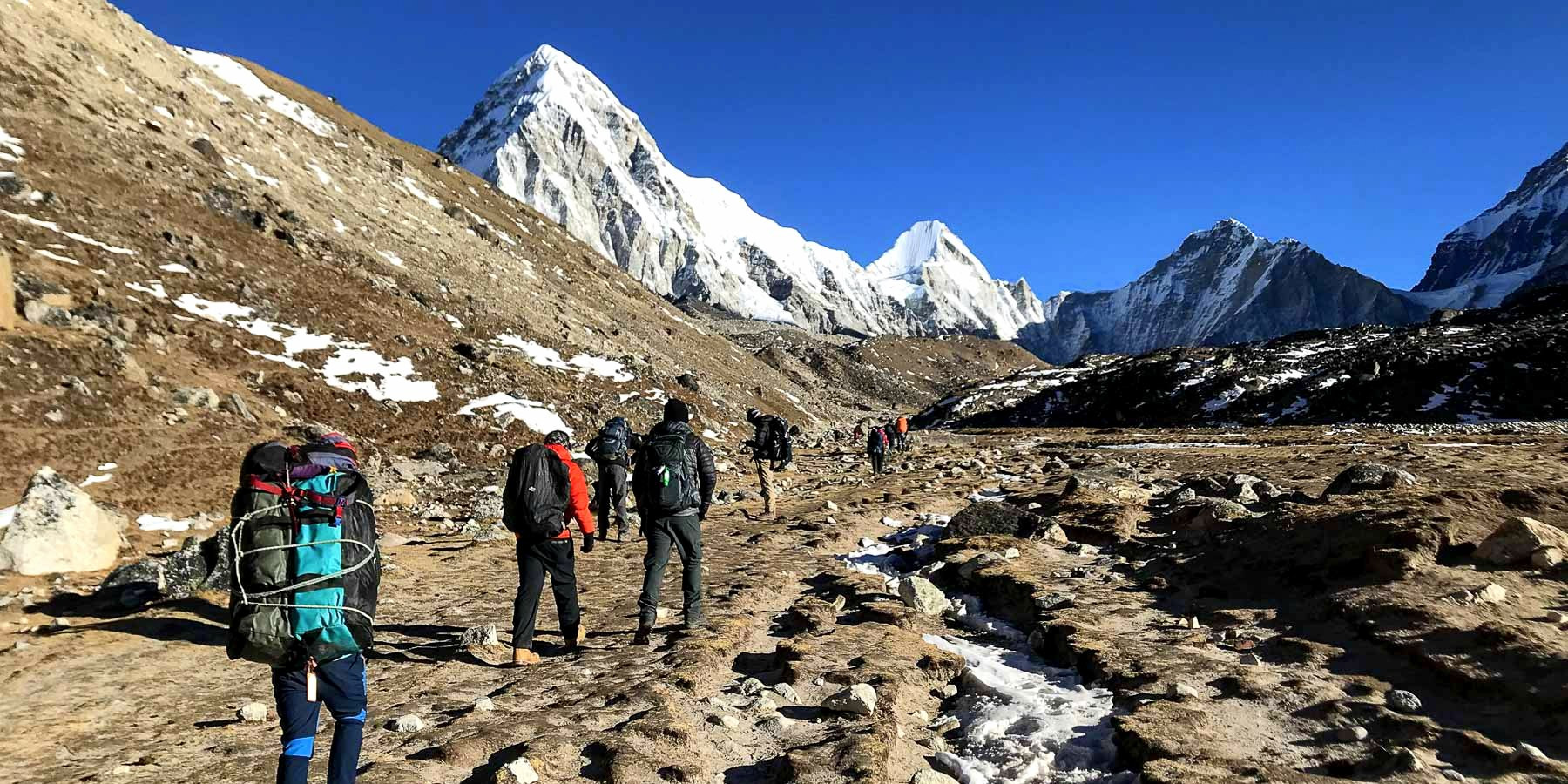Spring (March to May)– The Most Popular and Beautiful Season
Spring is often heralded as the ideal season for the Everest Base Camp Trek for several compelling reasons, making it a preferred choice for many trekkers planning their journey to the base of the world's highest peak. Here are the key factors that make spring an exceptional time for this adventure:
-
Stable and Clear Weather: Spring (March to May) offers stable and clear weather after winter, providing excellent visibility and stunning panoramic views of Mount Everest and the surrounding peaks that are hard to match during other times of the year.
-
Moderate Temperatures: In spring, temperatures in the Everest region become milder after winter, offering more comfortable daytime trekking conditions and reducing cold-related risks, especially at higher altitudes.
-
Vibrant Rhododendron Blooms: Spring transforms the trekking trails with colorful rhododendrons and wildflowers, making the journey through forested hillsides especially scenic and unique to the season.
-
Peak Trekking Season: Spring is a peak trekking season in Nepal, bringing lively trails, open teahouses, and a vibrant mix of trekkers, fostering cultural exchange and a welcoming atmosphere.
-
Ideal Conditions for Acclimatisation: Spring’s steady and moderate temperatures support better acclimatisation, helping trekkers adjust to high altitudes and lowering the risk of altitude sickness.
-
Wildlife Sightings: Spring is also a time when the region's flora and fauna come alive. The warmer weather encourages wildlife to be more active, offering trekkers the chance to spot various species of birds, mammals, and plants native to the Himalayas.
-
Cultural Festivals: Spring coincides with several Nepalese cultural festivals, including the famous Sherpa New Year, known as Losar, which falls in February or March. Participating in or witnessing these cultural festivities can add a rich cultural dimension to the trekking experience.
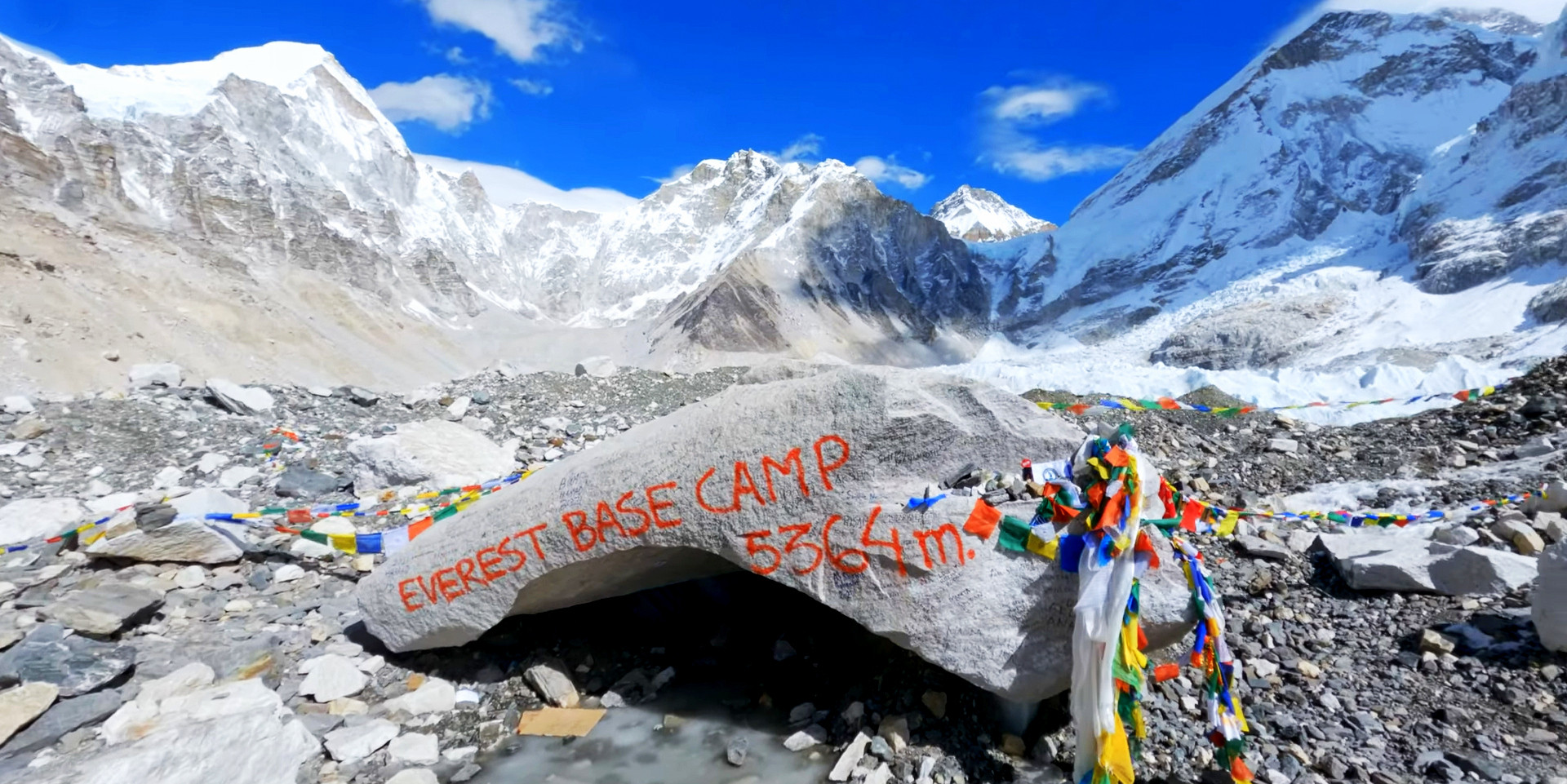
Key Features
- Best for: Clear views, blooming rhododendrons, and moderate weather.
- Temperature: 5°C to 15°C during the day; nights can drop below freezing at higher elevations.
Highlights:
- Blooming rhododendrons and alpine flowers.
- Excellent visibility of snow-capped peaks.
- The route is lively with trekkers from around the world.
- Opportunity to meet climbers preparing for Everest summit attempts.
- Downside: As it’s peak season, expect more crowded trails and teahouses. Booking in advance is essential.
Autumn (Late September to November)– The Peak Trekking Season
Autumn is another fantastic time for the Everest Base Camp trek. Post-monsoon, the air is crisp and the landscape looks freshly washed, offering breathtaking clarity.
-
Stable and Clear Weather: Autumn (late September to November) offers stable, clear weather after the monsoon, making it ideal for trekking with spectacular, unobstructed views of Everest and surrounding peaks.
-
Moderate Temperatures: Following the wet monsoon, autumn brings moderate temperatures to the Everest region. Though chilly at higher altitudes, the comfortable daytime weather makes trekking more pleasant and reduces cold-related challenges.
-
Cultural Festivals: Autumn coincides with several Nepalese cultural festivals, including the famous Dasahin, Tihar (festival of Lights) which falls in October and November. Participating in or witnessing these cultural festivities can add a rich cultural dimension to the trekking experience.
-
Peak Trekking Season: Autumn is Nepal’s peak trekking season, with bustling trails, open lodges, and a lively atmosphere, offering rich cultural exchange among global trekkers.
-
Ideal Conditions for Acclimatisation: Autum gradual temperature decrease and steady weather support better acclimatisation, helping reduce the risk of altitude sickness during high-altitude treks.
-
Wildlife Sightings: Autumn is a great time for wildlife spotting in the Everest region, as clear skies and crisp air make animals more active, allowing trekkers to see a variety of native birds, mammals, and plants in their natural environment.
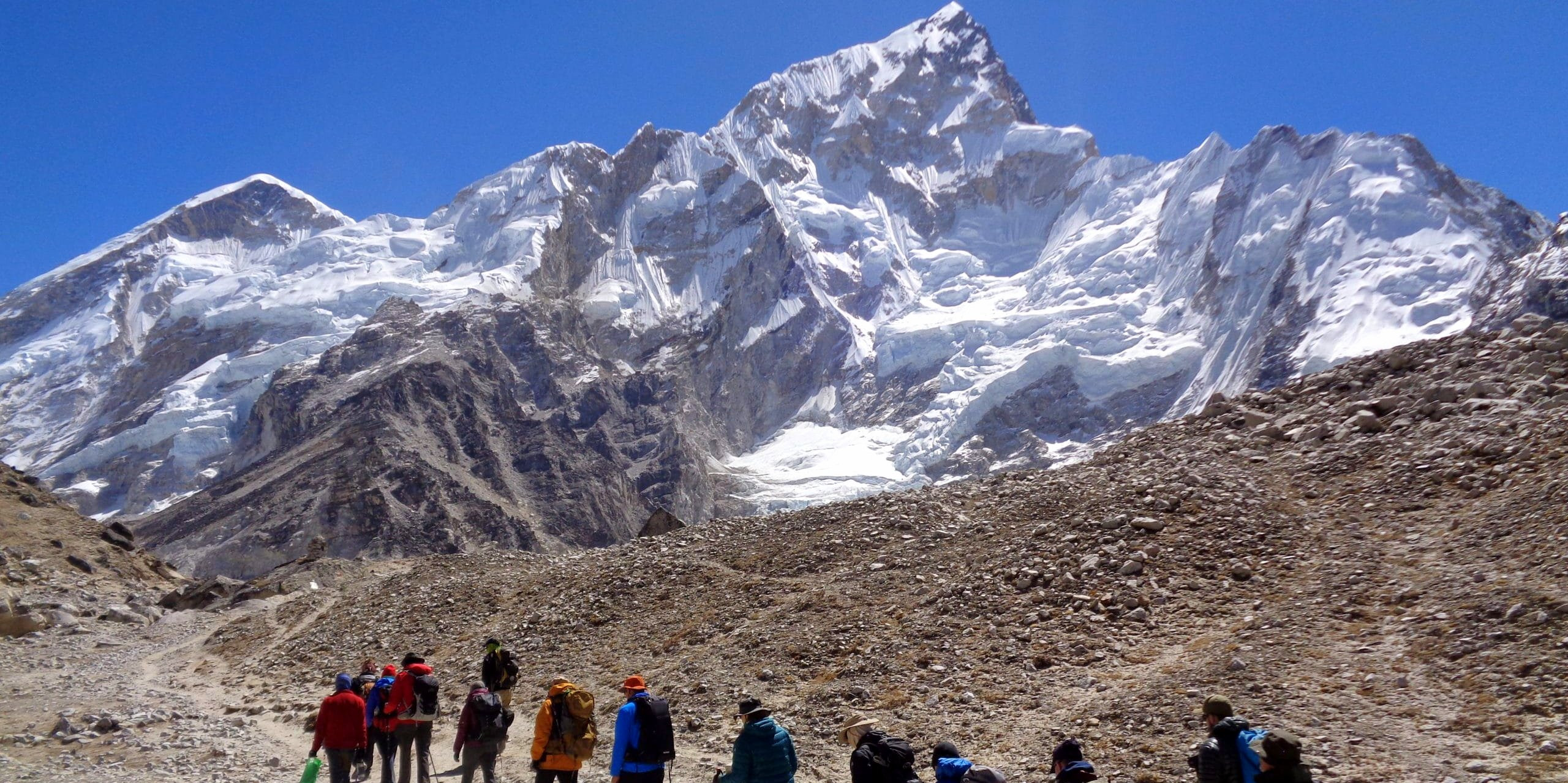
Key Features
Best for: Stunning mountain views and festive atmosphere.
Temperature: 0°C to 15°C during the day; colder at night.
Highlights:
- Unobstructed views of Everest and surrounding peaks.
- Cultural richness with major festivals like Dashain and Tihar.
- Dry trails and ideal weather conditions.
- Downside: Like spring, this is also a busy season, so expect to share the trails with many other trekkers.
Winter (December to February) – For the Adventurous and Prepared
Winter is the off-season for trekking in the Everest region due to cold temperatures and snow. However, for those who are well-prepared and want a quieter trail, this season can be magical.
- Extreme Cold Weather: Winter in the Everest region, spanning from December to February, is marked by crisp. Though the temperatures drop significantly, the cold dry air often results in spectacular, unobstructed views of Mount Everest and the surrounding Himalayan peaks. The low humidity and minimal cloud cover make winter an ideal time for photographers and trekkers seeking breathtaking panoramas without the summer haze or monsoon clouds.
- Cold Temperatures: Winter temperatures in the Everest region can be quite harsh, especially at higher altitudes where nighttime lows often plunge well below freezing. Daytime temperatures are generally cold but manageable with proper gear. Despite the chill, trekking in winter offers a peaceful and less crowded trail, making the experience more intimate and focused on the majestic landscape. Proper preparation and acclimatization are key to tackling the cold while enjoying the stunning surroundings
- Cultural Festivals: Although winter has fewer major festivals than autumn or spring, the region still celebrates important local traditions. The Sherpa community, for example, observes Losar, the Tibetan New Year, usually falling between January and February. Experiencing such festivals in the serene winter environment offers trekkers a unique glimpse into the rich cultural heritage of the Everest region.
- Low Trekking Season: Winter is considered the low trekking season for Everest Base Camp due to the cold and challenging weather. This means fewer trekkers on the trails and in the teahouses, allowing for a more tranquil and personalized trekking experience. Many lodges remain open, but it is advisable to check in advance and be prepared for more basic accommodations compared to peak seasons.
- Ideal Conditions for Acclimatization: The dry and stable winter weather aids acclimatization, although the cold requires trekkers to be extra cautious. The body adjusts gradually to the altitude, but due to the extreme temperatures, maintaining warmth and hydration becomes crucial. Guided treks with experienced leaders can help manage these conditions safely.
- Wildlife Sightings: Winter sees a quieter natural environment, but trekkers can still spot some hardy wildlife adapted to the cold, such as Himalayan tahrs and various bird species that remain active. The snow-covered landscapes provide a different perspective on the region’s flora and fauna, enhancing the sense of wilderness and solitude.
Key Features
Best for: Solitude and snow-covered landscapes.
Temperature: -10°C to 5°C during the day; extremely cold nights.
Highlights:
- Fewer trekkers on the trail.
- Pristine snow-covered scenery.
- Clear skies are still common on sunny days.
- Downside: Extremely cold temperatures, some teahouses may close at higher altitudes, and the risk of snow blocking the trail is higher.
Monsoon/ Summer (June to Early September) – Not Recommended, but Possible
The monsoon season brings heavy rainfall, especially in the lower parts of the trail, causing landslides and slippery paths.
- Unstable Weather: The rainy season in Nepal, from June to August, is characterized by frequent monsoon showers and overcast skies. Weather conditions can be unpredictable, with heavy rainfall causing slippery trails and occasional landslides. Visibility is often limited due to clouds and mist, making it harder to get clear views of Mount Everest and the surrounding peaks. Trekkers should be prepared for wet conditions and possible delays on the trail.
- Warm and Humid Temperatures: During the monsoon season, temperatures in the Everest region tend to be warmer and more humid compared to other times of the year. The combination of heat and moisture can make trekking physically demanding, requiring trekkers to stay hydrated and take extra care on muddy paths. While daytime temperatures are generally comfortable, the wet environment increases the risk of illness and fatigue, so proper rain gear and health precautions are essential.
- Fewer Cultural Events: The monsoon season is quieter in terms of festivals, as many cultural celebrations occur in spring or autumn. However, this period allows trekkers to experience the everyday life of local communities without the crowds. The lush greenery and vibrant landscapes offer a peaceful backdrop to cultural encounters with the Sherpa and other Himalayan people.
- Low Trekking Season: Monsoon is the low trekking season on the Everest Base Camp trail. Due to challenging weather and trail conditions, fewer trekkers venture into the region. This means less crowded paths and teahouses, but also limited services, as some lodges may close temporarily during heavy rains. It’s important to plan carefully and choose flexible itineraries when trekking in this season.
- Acclimatization Considerations: Acclimatization during the monsoon requires patience, especially since frequent rain can slow down progress. The damp and wet conditions may increase the risk of colds or other illnesses, so trekkers should prioritize rest and maintain good hygiene. Despite these challenges, gradual altitude gain remains crucial to minimize altitude sickness.
- Rich Flora and Wildlife: The monsoon season transforms the Everest region into a lush, green paradise. The forests and meadows burst with wildflowers, and the increased water availability brings vibrant biodiversity. Trekkers may spot various bird species, insects, and some mammals that thrive in the wetter environment, offering a unique natural experience different from the drier seasons.
Key Feature
Best for: Lush landscapes and solitude for seasoned trekkers.
Temperature: 10°C to 20°C; humid in lower elevations.
Highlights:
- Green and lush valleys.
- Fewer trekkers, peaceful trails.
- Discounted prices on accommodation and flights.
- Downside: Poor visibility due to clouds and rain, flight delays to/from Lukla, and leeches in the lower regions.
Final Thoughts: When Should You Go?
Best time overall: October and April for the ideal mix of weather, visibility, and comfort.
Best for solitude and challenge: Winter (December–February)
Best for flower lovers and climbing excitement: Spring (March–May)
No matter when you decide to go, preparation is key. Pack appropriately for the weather, and always check flight and trail conditions before heading out.
Plan Your Everest Base camp Trek with Confidence
At Relax Getaways, we offer flexible Everest Base Camp trekking packages tailored to your preferred season and comfort level—whether you're looking for classic treks or luxury experiences with helicopter returns. Let our local expertise guide you through one of the greatest adventures of your life.
Perks of doing Everest Base Camp Trek
Cultural Immersion in Sherpa Villages
Everest Base Camp Trek is not only a journey through some of the world's most stunning landscapes but also a profound cultural immersion into the lives of the Sherpa people. These mountain communities, known for their resilience, hospitality, and rich traditions, add an invaluable dimension to the trekking experience. We emphasis on cultural immersion, ensuring that trekkers have the opportunity to engage meaningfully with local customs, traditions, and ways of life.
-
Experience Sherpa Hospitality: The trek takes you through several Sherpa villages, including the bustling Namche Bazaar, the spiritual Tengboche, and the tranquil Phortse. In these communities, trekkers are welcomed with warm hospitality, offering a glimpse into the daily lives of the Sherpa people. The lodges and teahouses run by local families provide cosy accommodations and traditional meals, creating a homely atmosphere that enriches the trekking experience.
-
Explore Local Monasteries and Festivals: One of the cultural highlights of the trek is the opportunity to visit ancient monasteries, such as the famous Tengboche Monastery. These spiritual centres are not just architectural marvels but also hubs of Buddhist practice and culture. Depending on the timing of your trek, you might also have the chance to witness colourful festivals like Losar (Tibetan New Year) or Dumje, which celebrate Sherpa culture with music, dance, and traditional rituals.
-
Learn About Sherpa Heritage: The Sherpa people are renowned for their mountaineering prowess and deep connection to the Himalayas. Visiting local museums and cultural centres, such as the Sherpa Culture Museum in Namche Bazaar, offers insights into their history, religion, and relationship with the mountains. Trekkers can learn about the legendary Sherpa climbers, their traditions, and the evolution of mountaineering in the region.
-
Engage in Sustainable Tourism Practices: Relax Getaways is committed to sustainable tourism practices that respect local cultures and support the economy. By engaging with local artisans, enjoying meals prepared with locally sourced ingredients, and participating in community-led tourism initiatives, trekkers contribute positively to the conservation of Sherpa heritage and the sustainable development of the region.
-
Personal Connections: Perhaps the most impactful aspect of cultural immersion is the personal connections formed with the people you meet along the way. Whether it's sharing a cup of tea with a lodge owner, learning a few words of the Sherpa language, or listening to stories of life in the high Himalayas, these interactions create a deeper understanding and appreciation for the Sherpa way of life.
Embarking on the Everest Base Camp Trek with Relax Getaways in spring is an invitation to not only explore the natural wonders of the Everest region but also to immerse yourself in the rich cultural tapestry of the Sherpa communities. This journey offers a unique blend of adventure, spirituality, and cultural exchange, leaving trekkers with a profound sense of connection to the people and places of the Himalayas.
Wildlife Sightings
Everest Base Camp Trek offers opportunity for wildlife sightings. The Sagarmatha National Park, through which the trek passes, is a UNESCO World Heritage site and home to a variety of Himalayan flora and fauna. Spring, with its warmer weather and blossoming flora, invites a plethora of wildlife to emerge, making it an ideal time for trekkers interested in the natural world.
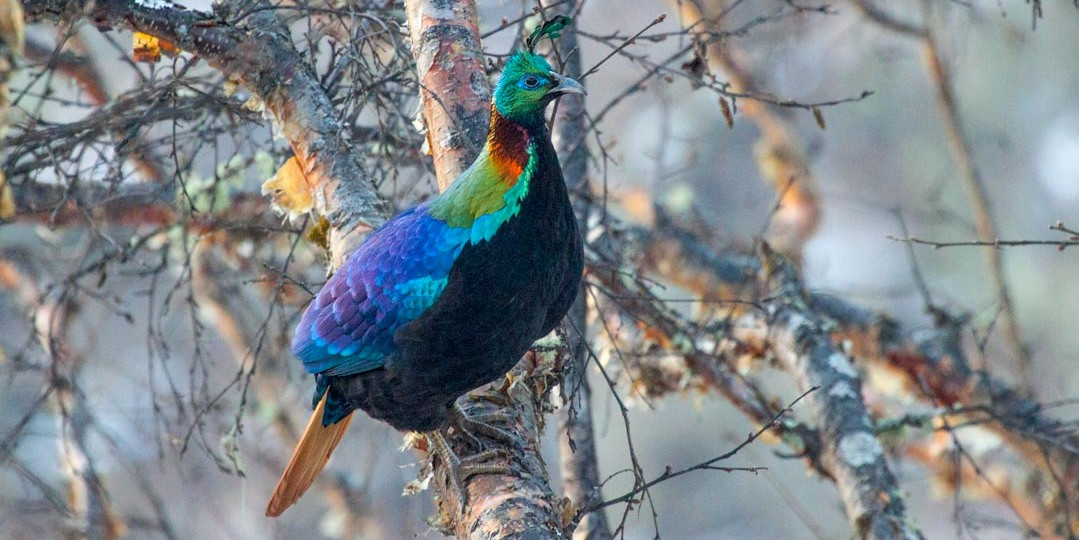
-
Diversity of Wildlife: The park is inhabited by several species adapted to life at high altitudes, including the elusive snow leopard, Himalayan tahr, musk deer, and red panda. Although sightings of the snow leopard are rare, the chance of spotting Himalayan tahr and musk deer are higher, especially in the forested areas and near the treeline. The region is also home to a variety of birds, including the colourful Impeyan pheasant, also known as the Danphe, which is Nepal's national bird.
-
Bird Watching Opportunities: Spring is an excellent time for bird watching as migratory birds return to the region and local species become more active. Trekkers can expect to see a variety of birdlife, from large birds of prey like the Himalayan griffon and lammergeier to smaller species such as the snow pigeon and the blood pheasant. The forests and open meadows along the trek are alive with the sounds and sights of these birds, adding an extra layer of excitement to the journey.
-
Conservation Efforts: The trek also offers insights into the conservation efforts in place to protect these species and their habitats. The Sagarmatha National Park's management practices aim to balance tourism with environmental protection, ensuring that future generations can also enjoy the region's natural beauty and biodiversity. Relax Getaways supports these efforts by promoting responsible trekking practices that minimise the impact on the environment and wildlife.
-
Engaging with Nature: For many trekkers, the possibility of wildlife sightings adds an element of anticipation and wonder to the journey. Relax Getaways encourages trekkers to remain vigilant and respectful of wildlife, keeping a safe distance and using binoculars or zoom lenses to observe animals without disturbing them. The experience of seeing a wild animal in its natural habitat is a powerful reminder of the beauty and fragility of the natural world.
-
Educational Aspect: Guides from Relax Getaways are knowledgeable about the local ecosystem and can provide valuable information about the wildlife encountered along the trek. This educational aspect enriches the trekking experience, offering a deeper understanding of the Himalayan environment and the importance of conservation.
Embarking on the Everest Base Camp Trek in spring with Relax Getaways not only promises adventure and cultural enrichment but also the chance to connect with the natural world. The potential for wildlife sightings adds an unpredictable and thrilling element to the trek, making each journey unique and memorable.
Kala Patthar: The view Point
Ascending Kala Patthar is the pinnacle experiences during your Everest Base Camp Trek, especially in the spring season. These iconic destinations offer trekkers not only a profound sense of achievement but also the most spectacular views of Mount Everest and the surrounding Himalayan giants.
-
Kala Patthar: The Best View of Everest: While Everest Base Camp offers the thrill of being at the foot of the world's highest peak, it is from Kala Patthar that trekkers get the best views of Everest. Situated at an elevation of 5,545 metres (18,192 feet), Kala Patthar provides a panoramic vista that includes Everest, Lhotse, Nuptse, and Changtse, among others. The climb to Kala Patthar is challenging, but the reward at the summit, especially at sunrise or sunset, is unparalleled. The way the light dances on the peaks and the shadows play across the Khumbu Glacier are sights that are etched in the memory of every trekker.
-
A Moment of Reflection: Standing at Everest Base Camp or the summit of Kala Patthar offers a moment of reflection on the journey's challenges and triumphs. It's a time to appreciate the beauty of the natural world, the resilience of the human spirit, and the camaraderie developed with fellow trekkers and the local Sherpa community. These experiences are more than just physical achievements; they are transformative moments that stay with you long after the trek concludes.
Choosing Relax Getaways for your Everest Base Camp Trek in spring means embarking on an adventure that is meticulously planned and supported, ensuring that the journey to Everest Base Camp and Kala Patthar is not just successful but also deeply meaningful.
Engaging in Sustainable Trekking
Engaging in sustainable trekking practices is at the heart of Relax Getaways' philosophy, especially for journeys as impactful as the Everest Base Camp Trek. As visitors to one of the most awe-inspiring yet fragile environments on earth, it's crucial that our actions reflect a commitment to preserving this natural wonder for future generations. Here's how we incorporate sustainability into every aspect of the trek, particularly in the spring season when the trails and teahouses are bustling with activity.
Minimising Environmental Impact
-
Carrying out all waste, including plastics and non-biodegradable materials.
-
Using refillable water bottles and water purification methods to reduce plastic waste.
-
Sticking to established trails to prevent soil erosion and protect plant life.
Supporting Local Communities
-
Staying in locally owned lodges and teahouses, which helps distribute tourism income more evenly.
-
Hiring local guides and porters, providing economic benefits directly to the community and ensuring respectful and authentic cultural exchanges.
-
Purchasing local products and services, from crafts to meals, helps sustain local businesses.
Promoting Cultural Respect
-
Visiting cultural sites like monasteries with sensitivity to religious practices.
-
Engaging with locals in a manner that respects their privacy and dignity.
-
Learning about local conservation efforts and how tourism impacts their way of life.
Participating in Conservation Efforts
-
Contribute to conservation projects, whether through donations or volunteer work.
-
Be informed about the challenges facing the Everest region, including climate change and its effects on glaciers and biodiversity.
-
Adopt energy-saving practices in lodges and teahouses, such as using solar-powered charging stations and minimising hot water use.
Educating Trekkers
-
Best practices for environmental conservation on the trail.
-
Health and safety tips that also consider sustainability, such as avoiding single-use plastics.
-
Cultural insights that foster a deeper understanding and appreciation of the region's heritage.
By choosing Relax Getaways for your Everest Base Camp Trek, you're not just embarking on an unforgettable journey; you're also contributing to the preservation and sustainability of one of the world's most extraordinary landscapes. Together, we can ensure that the beauty and culture of the Everest region remain vibrant and intact for many years to come.
Dynamic Weather Patterns
Everest Base Camp Trek, particularly in the spring season, is characterised by dynamic weather patterns that add an element of unpredictability and adventure to the journey. Relax Getaways understands the importance of being prepared for the variable conditions you may encounter on the trek. Spring, spanning from March to May, generally offers some of the most favourable weather for trekking in the Everest region, yet the weather can change rapidly in the mountains, presenting challenges and opportunities for trekkers.
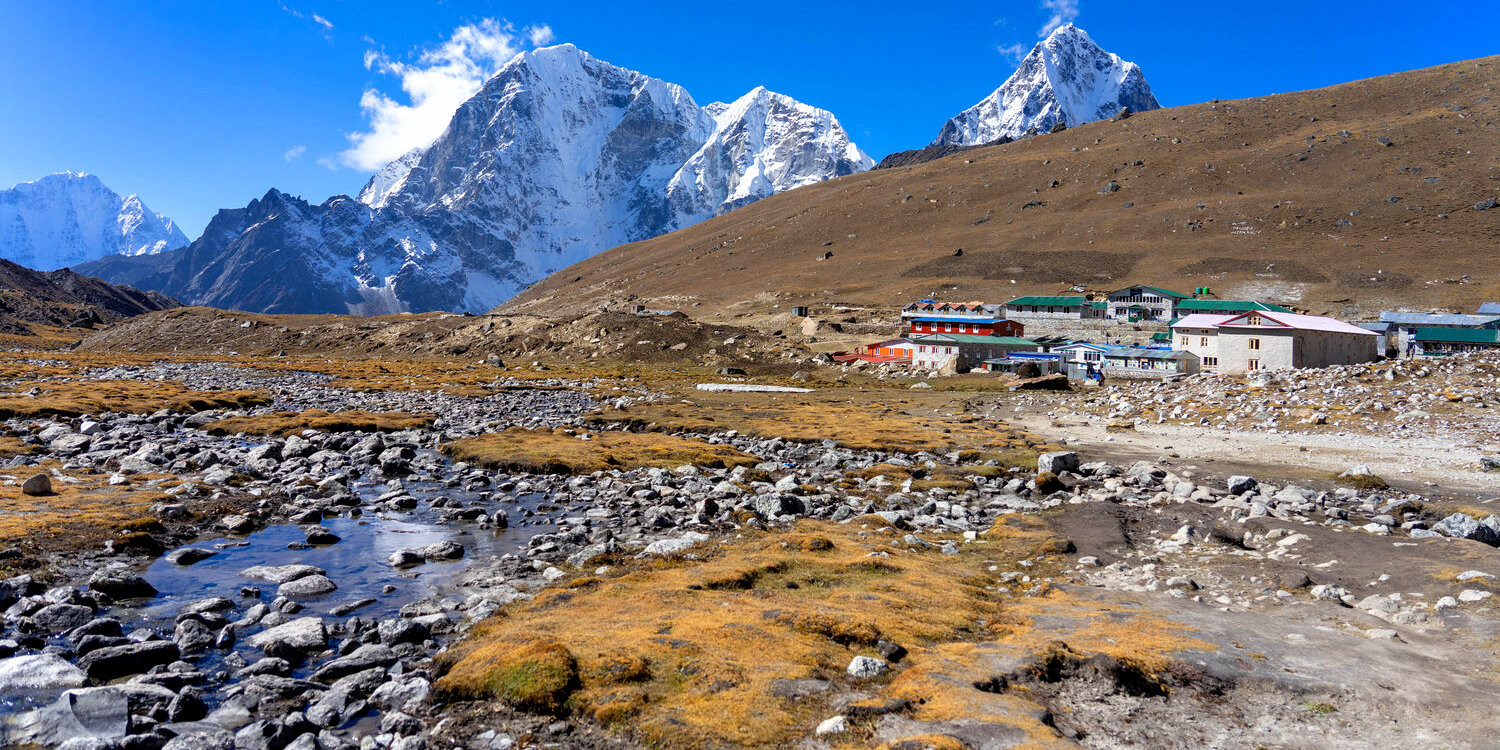
- March: The beginning of spring sees the transition from the cold winter. Days start to become warmer, but nights can still be bitterly cold, especially at higher altitudes.
- April: By April, temperatures continue to rise, offering warmer days. This month is known for its clear skies and excellent visibility, making it ideal for capturing breathtaking mountain vistas.
- May: As spring progresses into May, temperatures further increase, but so does the likelihood of afternoon clouds and occasional pre-monsoon showers, adding a refreshing contrast to the dry conditions.
Preparing for Weather Variability
-
Layered Clothing: Wearing layers that can be easily added or removed allows trekkers to adapt to changing temperatures throughout the day.
-
Protective Gear: Waterproof jackets, warm hats, gloves, and good-quality sunglasses are essential to protect against rain, wind, and strong UV radiation at high altitudes.
-
Flexible Itinerary: We design our itineraries with flexibility in mind, allowing for adjustments based on weather conditions to ensure the safety and comfort of our trekkers.
Embracing the Weather as Part of the Experience
- Clouds and Mists: While clear skies offer spectacular views, clouds and mists can add a mystical atmosphere to the mountains, creating magical and ethereal landscapes.
- Changing Conditions: Rapid weather changes can be exhilarating and offer a variety of experiences within a single day, from sunny mornings to snowy afternoons.
- Safety and Support: Safety is our top priority, and our experienced guides are well-trained to make decisions based on weather conditions to ensure the safety of the group. They are equipped with up-to-date weather information and know the terrain intimately, allowing them to guide trekkers safely through the dynamic weather patterns of the Everest region.
The dynamic weather patterns of the Everest Base Camp Trek in spring highlight the power and beauty of nature. They remind trekkers of the importance of respect, preparation, and flexibility when venturing into the high mountains. With Relax Getaways, trekkers can confidently embark on their adventure, knowing they are supported every step of the way through the changing moods of the Himalayas.
Preparing for Everest Base Camp Trek
Preparing for the Everest Base Camp Trek involves careful planning and preparation to ensure a successful and enjoyable experience. Here's how to get ready for your spring trek to Everest Base Camp:
Physical Preparation
-
Start Early: Begin your physical preparation at least 2-3 months before your trek. Focus on cardiovascular exercises such as running, cycling, and swimming to build your stamina.
-
Hiking Practice: Engage in regular hiking, preferably on varied terrains and inclines, to condition your legs for the long trekking days. If possible, practice with the backpack you plan to carry.
-
Altitude Training: While it's challenging to simulate high-altitude conditions, spending time at higher elevations, if accessible, can be beneficial. Alternatively, consider using altitude training masks.
Gear and Equipment
-
Quality Footwear: Invest in a good pair of waterproof, broken-in hiking boots to prevent blisters and discomfort.
-
Layered Clothing: The weather can vary significantly from warm days to cold nights. Pack layered clothing, including thermal base layers, fleece or down jackets, and a waterproof shell.
-
Sleeping Bag and Pad: A high-quality sleeping bag rated for low temperatures and a sleeping pad for extra insulation are essential for comfortable rest.
-
Sunglasses and Sunscreen: High UV exposure at altitude necessitates strong UV protection in sunglasses and high-SPF sunscreen.
-
Headlamp: For early morning or late evening treks, a headlamp is crucial.
Acclimatisation and Altitude Sickness Prevention
-
Understand the Risks: Familiarise yourself with the symptoms of altitude sickness and the importance of proper acclimatisation.
-
Plan a Gradual Ascent: Choose an itinerary that allows for a gradual ascent and includes acclimatisation days.
-
Stay Hydrated: Drink plenty of water throughout the trek to aid acclimatisation.
Travel Insurance
- Get Adequate Coverage: Ensure your travel insurance covers high-altitude trekking up to at least 6,000 meters (19,685 feet) and includes medical evacuation and repatriation.
Logistics and Permits
-
Flights and Transfers: Book your international flights to Kathmandu and the domestic flight to Lukla well in advance.
-
Trekking Permits: Ensure you have the necessary permits. A reputable trekking company can arrange these for you.
Health and Medication
-
Medical Check-Up: Consult with your doctor before the trek, especially if you have pre-existing health conditions.
-
First-Aid Kit: Carry a personal first-aid kit with essential medication for altitude sickness, diarrhoea, and other common ailments.
Hiring a Guide or Porter
- Consider Professional Support: Hiring a guide or porter through a reputable trekking company can enhance your experience. Guides offer valuable insights and ensure safety, while porters can alleviate the physical strain of carrying your pack.
Mental Preparation
- Be Prepared for Challenges: Mental resilience is as crucial as physical preparation. Be ready for tough days, basic accommodations, and simple food. Embrace the experience with an open and positive mindset.
Sustainable Trekking Practices
- Respect the Environment: Practice Leave No Trace principles to minimise your impact on the fragile ecosystem of the Everest region.
Preparing thoroughly for the Everest Base Camp Trek in the spring is key to enjoying this incredible journey safely and comfortably. By addressing physical fitness, gear, health, and logistical aspects well in advance, you'll set the stage for a memorable adventure in the Himalayas.
The Everest Base Camp Trek in spring offers an unrivalled blend of breathtaking landscapes, rich culture, and personal challenge. With stable weather, vibrant rhododendron blooms, and optimal temperatures, spring provides the perfect backdrop for this iconic trek. Proper preparation, including physical fitness, gear, and acclimatisation knowledge, is key to enjoying the journey. Partnering with a reputable company like Relax Getaways ensures a safe, enriching experience that respects the local environment and culture. This trek is not just a physical journey but a transformative experience, promising lasting memories and personal growth amidst the majestic Himalayas.
FAQs for Everest Base Camp Trek in Spring
Q. What is the best time to do the Everest Base Camp Trek in the spring?
A. The best time for the Everest Base Camp Trek in spring is from March to May. During these months, the weather is generally stable with clear skies, and the trails are adorned with blooming rhododendrons, offering spectacular views of the Himalayas.
Q. How cold does it get on the Everest Base Camp Trek in the spring?
A. Temperatures during the spring season can vary widely. Daytime temperatures can be quite comfortable, ranging from 10°C to 15°C (50°F to 59°F), while nighttime temperatures at higher elevations can drop below freezing, especially in March and April. It's essential to prepare for cold nights.
Q. Do I need a guide for the Everest Base Camp Trek in the spring?
A. While it's possible to trek independently, hiring a guide is highly recommended, especially for novice trekkers. A guide ensures safety, provides valuable insights into local culture and nature, and can help navigate any challenges that arise due to weather or health issues.
Q. How do I prevent altitude sickness on the trek?
A. To minimise the risk of altitude sickness, ensure your itinerary includes ample time for acclimatisation, ascend slowly, stay hydrated, avoid alcohol and smoking, and consider taking altitude sickness medication after consulting with a doctor.
Q. How much does the Everest Base Camp Trek cost in the spring?
A. The cost can vary widely depending on factors like the length of your trek, the level of comfort you desire, whether you hire a guide and/or porter, and your spending on meals and accommodations. On average, expect to spend between $1,000 and $3,000, excluding international flights.
Q. Can I trek to Everest Base Camp without prior trekking experience?
A. Yes, it's possible to complete the trek without prior high-altitude trekking experience. However, good physical fitness is crucial, and it's beneficial to engage in cardio, strength training, and hiking to prepare your body for the demands of the trek.
Q. Are permits required for the Everest Base Camp Trek in spring?
A. Yes, trekkers need to obtain a TIMS (Trekkers' Information Management Systems) card and a Sagarmatha National Park entry permit. If you're trekking with a company, they can arrange these permits for you.
Q. How busy is the trail in spring?
A. Spring is one of the peak seasons for the Everest Base Camp Trek, so trails and teahouses tend to be busier than in off-peak months. However, the vibrant atmosphere and the chance to meet fellow trekkers from around the world add to the experience.
Q. What wildlife can I see during the trek in spring?
A. While wildlife sightings are never guaranteed, you may spot species such as Himalayan tahr, musk deer, and various bird species, including the national bird of Nepal, the Danphe. The spring season, with its warmer weather, increases the chances of wildlife sightings.
For the other Nepal Tour and trekking suggestions.
If you are looking for different kinds of Nepal Packages, feel free to contact us.
